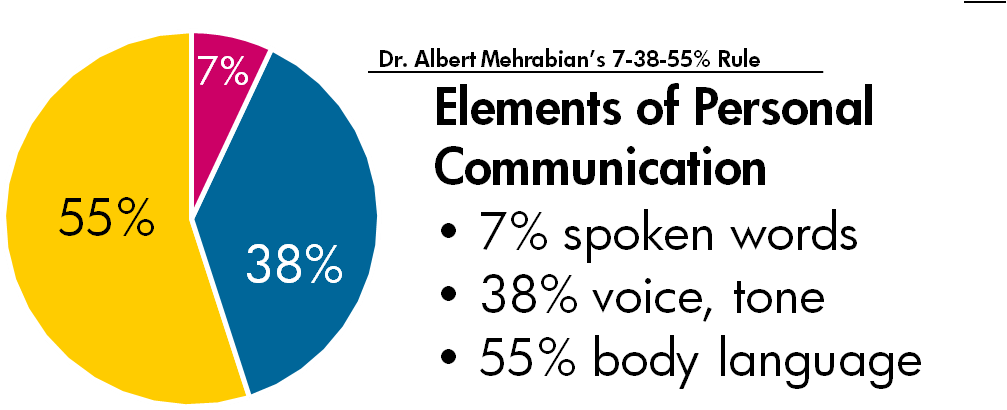
In communication, a speaker’s words are only a fraction of his efforts. The pitch and tone of his voice, the speed and rhythm of the spoken word, and the pauses between those words may express more than what is being communicated by words alone. Further, his gestures, posture, pose and expressions usually convey a variety of subtle signals. These non-verbal elements can present a listener with important clues to the speaker’s thoughts and feelings and thus substantiate or contradict the speaker’s words.
The most commonly and casually cited study on the relative importance of verbal and nonverbal messages in personal communication is one by Prof. Albert Mehrabian of the University of California in Los Angeles. In the 1970s, his studies suggested that we overwhelmingly deduce our feelings, attitudes, and beliefs about what someone says not by the actual words spoken, but by the speaker’s body language and tone of voice.
In fact, Prof. Mehrabian quantified this tendency: words, tone of voice, and body language respectively account for 7%, 38%, and 55% of personal communication.
The non-verbal elements are particularly important for communicating feelings and attitude, especially when they are incongruent: if words and body language disagree, one tends to believe the body language.
If a speaker’s words and body language differ, listeners are more likely to believe the nonverbal communication of the speaker, not his words. For example, suppose a person states, “I don’t have a problem with you!” while avoiding eye-contact, looking anxious, and maintaining a closed body language. Irrespective of the person’s internal monologue, the listener will probably trust the predominant form of communication, which according to Prof. Mehrabian’s findings is non-verbal (38% + 55%), rather than the literal meaning of the words (7%.)
I have two arguments against the oversimplified interpretation of the “7-38-55 Rule.” In the first place, it is very difficult to quantify the impact of tone of voice and body language on the effectiveness of communication. Secondly, such quantifications are very subjective and cannot be applied as a rule to all contexts. Prof. Mehrabian himself has cautioned,
“Total Liking = 7% Verbal Liking + 38% Vocal Liking + 55% Facial Liking. Please note that this and other equations regarding relative importance of verbal and nonverbal messages were derived from experiments dealing with communications of feelings and attitudes (i.e., like—dislike). Unless a communicator is talking about their feelings or attitudes, these equations are not applicable.”
This study is a convenient—if not accurate—reminder that nonverbal cues can be more valuable and telling than verbal ones. Therefore, to be effective and persuasive in our verbal communication—in presentations, public speaking, or personal communication—it is essential to complement our words with the right tone and voice and the appropriate body language.